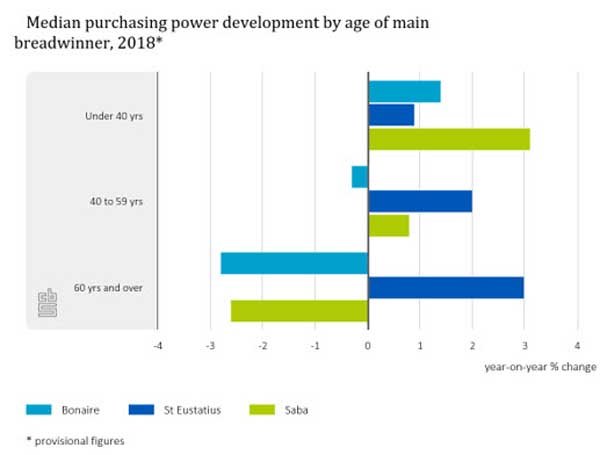Residents of Saba and Bonaire lost purchasing power relative to 2017. In contrast, St Eustatius once again recorded a rise in consumer purchasing power in 2018. The median increase was 2 percent relative to 2017. Statia’s low-income households benefited in particular, due to an additional increase in statutory minimum wages and social benefits in 2018. Statistics Netherlands (CBS) reports this based on newly released figures.
Purchasing power on St Eustatius has risen year after year since 2012. Improved purchasing power means that incomes are rising more than average price levels and consumers can afford to buy more goods and services. A median increase of 2 percent means that half of the population see their spending power rise by at least 2 percent while the other half see it change by less than 2 percent. 44 percent of Statia’s population saw a decrease. On Bonaire and Saba, the population lost purchasing power for the first time since 2012; the median decrease amounted to 1.1 and 0.3 percent respectively.

Highest gain among lowest income groups on Statia
On Saba, the median increase in purchasing power improved only for households in the two upper income quartiles. Workers benefited from a median increase of 1 percent.
At 3.4 percent, the sharpest median increase in purchasing power was recorded on St Eustatius in the lowest income quartile (25th percentile). Contrary to St Eustatius, spending power on Bonaire declined for all income groups. The lowest income quartile recorded the strongest decline in purchasing power, namely 2.6 percent. Even for the working population, it did not improve: they lost 0.5 percent of their spending power.
All household types benefited on Statia
On St Eustatius, the median purchasing power rose for all types of households. At 3.5 percent, the sharpest increase was seen among single-parent families, while couples with and couples without children gained 2.6 and 2.2 percent respectively. On Bonaire and Saba, (mainly) households with children benefited. For single-person households and households of couples without children, the median purchasing power dropped by 2 percent.
More spending power for all ages on St Eustatius
On St Eustatius, purchasing power improved across all the age groups. Residents aged 60 and over saw their spending power improve by 3 percent, partly due to additional increases in statutory pension benefits (AOV). Benefits were not raised on Saba and were increased only slightly on Bonaire. Relatively high consumer price inflation on these islands caused a decline in purchasing power of 2.8 and 2.6 percent respectively.

Sources:
StatLine – Caribbean NL; purchasing power development persons in private households
Explanation
Purchasing power development
Purchasing power developments per person are calculated as year-on-year percentage changes in that person’s standardised disposable household income, adjusted for price changes. These percentage-based income changes are ranked from high to low, with the middle or median value reflecting the purchasing power development of that particular (sub)population. Personal (dynamic) purchasing power may fluctuate for all kinds of reasons. For example, a wage increase, a promotion, taking up of a (new) job, retirement. Furthermore, changes in household composition (e.g. a child moving out or a couple separating) may also result in income changes. All these changes are reflected in the dynamic purchasing power development.
Income groups
The mean standardised disposable income is calculated for each household member over 2017 and 2018. The classification into income quartile groups is based on these averages over 2017 and 2018. This is the so-called adjustment for regression-to-the-mean effects.
Additional increase in benefits
With a view to improving livelihood security and combating poverty, in 2018 statutory minimum wages and social benefits such as the AOV (statutory pension), the AWW (widow, widower & orphan pension) and the ‘onderstand’ (income support) in the Caribbean Netherlands were indexed on the basis of the CBS consumer price index (CPI) for Q3 2017. On Saba, benefits and statutory minimum wages were not raised due to deflation amounting to 1.3 percent. On Bonaire and St Eustatius, benefits and statutory wages were indexed at 0.6 and 2.1 percent respectively. In the same period, on St Eustatius a special adjustment was made to the statutory minimum hourly wage and the AOV, AWW and ‘onderstand’ benefits on the basis of figures taken from the income statistic published by CBS. Benefits were raised by an additional 2.9 percent, resulting in a total increase of 5 percent on St Eustatius.
CBS
 Archive of posts from Saba-News.com Archive Saba News
Archive of posts from Saba-News.com Archive Saba News